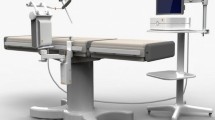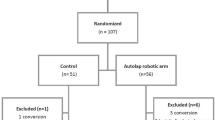Abstract
In the last 2 decades, multiple robotic camera holders have been developed to improve camera steering during laparoscopic surgery. A new image-based steering method has been developed for more intuitive camera control. In this article, the efficiency and user experience of image-based steering were compared to conventional steering methods. Four participants (two senior surgical registrars, one junior surgical registrar and a technical medicine student) were enrolled in this study. All participants performed multiple camera steering exercises with three different steering modalities in randomized order: image-based, joystick and manual camera steering. Steering of the laparoscope was evaluated by execution time and with the SMEQ and NASA-TLX questionnaires to analyze user experience. A total of 267 camera steering exercises were performed. The analyzed data showed a significantly shorter execution time for manual camera steering compared to image-based robotic steering (p = 0.001) and joystick robotic steering (p = 0.001). The participants reported the lowest user experience with joystick camera steering. The results of the questionnaires showed no significant difference in all subscales of user experience for image-based and manual camera steering. Manual camera steering resulted in significantly higher perceived physiological workload scores (M = 30.0, IQR = 27.5) compared to image-based (M = 10, IQR = 5.0) and joystick camera steering (M = 15.0, IQR = 10.0). Manual control of the laparoscope remains the fastest steering method at the expense of a high physical workload. Using image-based camera steering is a viable alternative to the current joystick control of robotic camera holders, as it improves speed and user experience. The study results suggest that optimisation of robotic camera steering with algorithms based on image analysis is a promising technology.



Similar content being viewed by others
References
Tukanova K, Markar SR, Jamel S et al (2020) An international comparison of the utilisation of and outcomes from minimal access surgery for the treatment of common abdominal surgical emergencies. Surg Endosc 34:2012–2018. https://doi.org/10.1007/s00464-019-06980-y
Jaschinski T, Mosch CG, Eikermann M et al (2018) Laparoscopic versus open surgery for suspected appendicitis. Cochrane Database Syst Rev 11:CD001546
Moloo H, Haggar F, Coyle D et al (2010) Hand assisted laparoscopic surgery versus conventional laparoscopy for colorectal surgery. Cochrane Database Syst Rev. https://doi.org/10.1002/14651858.cd006585.pub2
Vennix S, Pelzers L, Bouvy N et al (2014) Laparoscopic versus open total mesorectal excision for rectal cancer. Cochrane Database Syst Rev 4:CD005200. https://doi.org/10.1002/14651858.CD005200.pub3
Best LMJ, Mughal M, Gurusamy KS (2016) Laparoscopic versus open gastrectomy for gastric cancer. Cochrane Database Syst Rev 3:CD011389
Abraha I, Binda GA, Montedori A et al (2017) Laparoscopic versus open resection for sigmoid diverticulitis. Cochrane DatabaseSyst Rev 11:CD009277
Limb C, Rockall T (2020) Principles of laparoscopic surgery. Surg (United Kingdom) 38:161–171
Graafland M, Bok K, Schreuder HWR, Schijven MP (2014) A multicenter prospective cohort study on camera navigation training for key user groups in minimally invasive surgery. Surg Innov 21:312–319. https://doi.org/10.1177/1553350613505714
Siddaiah-Subramanya M, Tiang K, Nyandowe M (2017) A new era of minimally invasive surgery: progress and development of major technical innovations in general surgery over the last decade. Surg J 03:e163–e166. https://doi.org/10.1055/s-0037-1608651
Huettl F, Lang H, Paschold M et al (2020) Rating of camera navigation skills in colorectal surgery. Int J Colorectal Dis 35:1111–1115. https://doi.org/10.1007/s00384-020-03543-9
Huber T, Paschold M, Schneble F et al (2018) Structured assessment of laparoscopic camera navigation skills: the SALAS score. Surg Endosc 32:4980–4984. https://doi.org/10.1007/s00464-018-6260-7
Voorhorst F, Meijer D, Overbeeke C, Smets G (1998) Depth perception in laparoscopy through perception-action coupling. Minim Invasive Ther Allied Technol 7:325–334. https://doi.org/10.3109/13645709809152876
Amin MSA, Aydin A, Abbud N et al (2020) Evaluation of a remote-controlled laparoscopic camera holder for basic laparoscopic skills acquisition: a randomized controlled trial. Surg Endosc. https://doi.org/10.1007/s00464-020-07899-5
Jaspers JEN, Breedveld P, Herder JL, Grimbergen CA (2004) Camera and instrument holders and their clinical value in minimally invasive surgery. Surg Laparosc Endosc Percutaneous Tech 14:145–152
Arezzo A, Testa T, Ulmer F et al (2000) Sistemi di posizionamento per Solo chirurgia endoscopica. Minerva Chir 55:635–641
Kavoussi LR, Moore RG, Adams JB, Partin AW (1995) Comparison of robotic versus human laparoscopic camera control. J Urol 154:2134–2136. https://doi.org/10.1016/S0022-5347(01)66715-6
Wijsman PJM, Molenaar L, Van’t Hullenaar CDP et al (2019) Ergonomics in handheld and robot-assisted camera control: a randomized controlled trial. Surg Endosc. https://doi.org/10.1007/s00464-019-06678-1
van’t Hullenaar CDP, Bos P, Broeders IAMJ (2019) Ergonomic assessment of the first assistant during robot-assisted surgery. J Robot Surg 13:283–288. https://doi.org/10.1007/s11701-018-0851-0
Wijsman PJM, Broeders IAMJ, Brenkman HJ et al (2018) First experience with THE AUTOLAPTM SYSTEM: an image-based robotic camera steering device. Surg Endosc 32:2560–2566. https://doi.org/10.1007/s00464-017-5957-3
Hart SG, Staveland LE (1988) Development of NASA-TLX (Task Load Index): results of empirical and theoretical research. Adv Psychol. https://doi.org/10.1016/S0166-4115(08)62386-9
Voros S, Long JA, Cinquin P (2006) Automatic localization of laparoscopic instruments for the visual servoing of an endoscopic camera holder. Med Image Comput Comput Assist Interv. 2006;9(Pt 1):535–542. https://doi.org/10.1007/11866565_66
Voros S, Long J-A, Cinquin P (2007) Automatic detection of instruments in laparoscopic images: a first step towards high-level command of robotic endoscopic holders. Int J Rob Res 26:1173–1190. https://doi.org/10.1177/0278364907083395
Zahiri M, Nelson CA, Gonzalo Garay-Romero R, Oleynikov D (2016) Integration of automated camera steering for robotic single-site surgery. Mechanisms and machine science. Kluwer Academic Publishers, New York, pp 153–160
Bouget D, Allan M, Stoyanov D, Jannin P (2017) Vision-based and marker-less surgical tool detection and tracking: a review of the literature. Med Image Anal 35:633–654
Yang C, Zhao Z, Hu S (2020) Image-based laparoscopic tool detection and tracking using convolutional neural networks: a review of the literature. Comput Assist Surg 25:15–28
Pastrana-Vidal RR, Gicquel JC, Colomes C, Cherifi H (2004) Sporadic frame dropping impact on quality perception. Hum Vis Electron Imaging IX 5292:182
Frame rate vs frame time—the CGVR lab. https://cgvr.cs.ut.ee/wp/index.php/frame-rate-vs-frame-time/. Accessed 25 Aug 2021
Pratomo AH, Zakaria MS, Prabuwono AS, Liong CY (2013) Camera calibration: transformation real-world coordinates into camera coordinates using neural network. Communications in computer and information science. Springer Verlag, Berlin, pp 345–360
Acknowledgements
We are very grateful to Mr. Michael Orrell from Oxford University Hospitals. We would like to thank him for his advice and comments relating to the English language and grammar used in this manuscript.
Author information
Authors and Affiliations
Corresponding author
Ethics declarations
Conflict of interest
P.J.M. Wijsman was a Clinical Field Engineer of Medical Surgery Technologies ltd (MST) from 2016 to 2018. I.A.M.J. Broeders is a consultant for Johnson & Johnson and Intuitive Surgical. F.J. Voskens, L. Molenaar and C.D.P. van’t Hullenaar have no conflicts of interest or financial ties to disclose.
Additional information
Publisher's Note
Springer Nature remains neutral with regard to jurisdictional claims in published maps and institutional affiliations.
Supplementary Information
Below is the link to the electronic supplementary material.
Supplementary file1 (MP4 56686 KB)
Rights and permissions
About this article
Cite this article
Wijsman, P.J.M., Molenaar, L., Voskens, F.J. et al. Image-based laparoscopic camera steering versus conventional steering: a comparison study. J Robotic Surg 16, 1157–1163 (2022). https://doi.org/10.1007/s11701-021-01342-0
Received:
Accepted:
Published:
Issue Date:
DOI: https://doi.org/10.1007/s11701-021-01342-0




